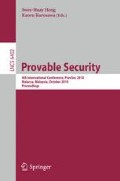Abstract
In this paper, we present a new public key encryption scheme which is proven chosen-ciphertext (CCA) secure under the decisional Diffie-Hellman (DDH) assumption. The main motivation behind this scheme is to clarify the essential mechanism for yielding CCA-security from the DDH assumption. The structure and security proof of our scheme is simple, and it is likely that even non-experts can immediately understand them with ease. We consider that our scheme is helpful for convincing a wide range of users (including developers and students who are just starting to study CCA-secure encryption) how the Cramer-Shoup cryptosystem and its variants work.
Access this chapter
Tax calculation will be finalised at checkout
Purchases are for personal use only
Preview
Unable to display preview. Download preview PDF.
References
Abe, M., Gennaro, R., Kurosawa, K., Shoup, V.: Tag-KEM/DEM: a new framework for hybrid encryption and a new analysis of Kurosawa-Desmedt KEM. In: Cramer, R. (ed.) EUROCRYPT 2005. LNCS, vol. 3494, pp. 128–146. Springer, Heidelberg (2005)
Boneh, D., Boyen, X.: Efficient selective-ID secure identity-based encryption without random oracles. In: Cachin, C., Camenisch, J.L. (eds.) EUROCRYPT 2004. LNCS, vol. 3027, pp. 223–238. Springer, Heidelberg (2004)
Boneh, D., Shparlinski, I.: On the unpredictability of bits of the elliptic curve Diffie-Hellman scheme. In: Kilian, J. (ed.) CRYPTO 2001. LNCS, vol. 2139, pp. 201–212. Springer, Heidelberg (2001)
Boneh, D., Venkatesan, R.: Hardness of computing the most significant bits of secret keys in Diffie-Hellman and related schemes. In: Koblitz, N. (ed.) CRYPTO 1996. LNCS, vol. 1109, pp. 129–142. Springer, Heidelberg (1996)
Cash, D., Kiltz, E., Shoup, V.: The twin Diffie-Hellman problem and applications. In: Smart, N.P. (ed.) EUROCRYPT 2008. LNCS, vol. 4965, pp. 127–145. Springer, Heidelberg (2008)
Cramer, R., Hofheinz, D., Kiltz, E.: A twist on the Naor-Yung paradigm and its application to efficient CCA-secure encryption from hard search problems. In: Micciancio, D. (ed.) TCC 2010. LNCS, vol. 5978, pp. 146–164. Springer, Heidelberg (2010)
Cramer, R., Shoup, V.: A practical public key cryptosystem provably secure against adaptive chosen ciphertext attack. In: Krawczyk, H. (ed.) CRYPTO 1998. LNCS, vol. 1462, pp. 13–25. Springer, Heidelberg (1998)
Dolev, D., Dwork, C., Naor, M.: Non-malleable cryptography. In: Proc. of STOC 1991, pp. 542–552 (1991)
Goldreich, O., Levin, L.A.: A hard-core predicate for all one-way functions. In: Proc. of STOC 1989, pp. 25–32 (1989)
Hanaoka, G., Imai, H., Ogawa, K., Watanabe, H.: Chosen ciphertext secure public key encryption with a simple structure. In: Matsuura, K., Fujisaki, E. (eds.) IWSEC 2008. LNCS, vol. 5312, pp. 20–33. Springer, Heidelberg (2008)
Hanaoka, G., Kurosawa, K.: Efficient chosen ciphertext secure public key encryption under the computational Diffie-Hellman assumption. In: Pieprzyk, J. (ed.) ASIACRYPT 2008. LNCS, vol. 5350, pp. 308–325. Springer, Heidelberg (2008)
Hofheinz, D., Kiltz, E.: Secure hybrid encryption from weakened key encapsulation. In: Menezes, A. (ed.) CRYPTO 2007. LNCS, vol. 4622, pp. 553–571. Springer, Heidelberg (2007)
Kurosawa, K., Desmed, Y.: A new paradigm of hybrid encryption scheme. In: Franklin, M. (ed.) CRYPTO 2004. LNCS, vol. 3152, pp. 426–442. Springer, Heidelberg (2004)
Kiltz, E., Mohassel, P., O’Neill, A.: Adaptive trapdoor functions and chosen-ciphertext security. In: Eurocrypt 2010. LNCS, vol. 6110, pp. 673–692. Springer, Heidelberg (2010)
Luby, M., Rackoff, C.: How to construct pseudorandom permutations from pseudorandom functions. SIAM J. Comput. 17(2), 373–386 (1988)
Myers, S., Shelat, A.: Bit encryption is complete. In: Proc. of FOCS 2009, pp. 607–616 (2009)
Naor, M., Yung, M.: Public-key cryptosystems provably secure against chosen ciphertext attacks. In: Proc. of STOC 1990, pp. 427–437 (1990)
Okamoto, T., Pointcheval, D.: The gap-problems: a new class of problems for the security of cryptographic schemes. In: Kim, K.-c. (ed.) PKC 2001. LNCS, vol. 1992, pp. 104–118. Springer, Heidelberg (2001)
Peikert, C., Waters, B.: Lossy trapdoor functions and their applications. In: Proc. of STOC 2008, pp. 187–196 (2008)
Rackoff, C., Simon, D.R.: Non-interactive zero-knowledge proof of knowledge and chosen ciphertext attack. In: Feigenbaum, J. (ed.) CRYPTO 1991. LNCS, vol. 576, pp. 433–444. Springer, Heidelberg (1992)
Rosen, A., Segev, G.: Chosen-ciphertext security via correlated products. In: Reingold, O. (ed.) TCC 2009. LNCS, vol. 5444, pp. 419–436. Springer, Heidelberg (2009)
Shoup, V.: Using hash functions as a hedge against chosen ciphertext attack. In: Preneel, B. (ed.) EUROCRYPT 2000. LNCS, vol. 1807, pp. 275–288. Springer, Heidelberg (2000)
Author information
Authors and Affiliations
Editor information
Editors and Affiliations
Rights and permissions
Copyright information
© 2010 Springer-Verlag Berlin Heidelberg
About this paper
Cite this paper
Yamada, S., Hanaoka, G., Kunihiro, N. (2010). Toward an Easy-to-Understand Structure for Achieving Chosen Ciphertext Security from the Decisional Diffie-Hellman Assumption. In: Heng, SH., Kurosawa, K. (eds) Provable Security. ProvSec 2010. Lecture Notes in Computer Science, vol 6402. Springer, Berlin, Heidelberg. https://doi.org/10.1007/978-3-642-16280-0_16
Download citation
DOI: https://doi.org/10.1007/978-3-642-16280-0_16
Publisher Name: Springer, Berlin, Heidelberg
Print ISBN: 978-3-642-16279-4
Online ISBN: 978-3-642-16280-0
eBook Packages: Computer ScienceComputer Science (R0)

